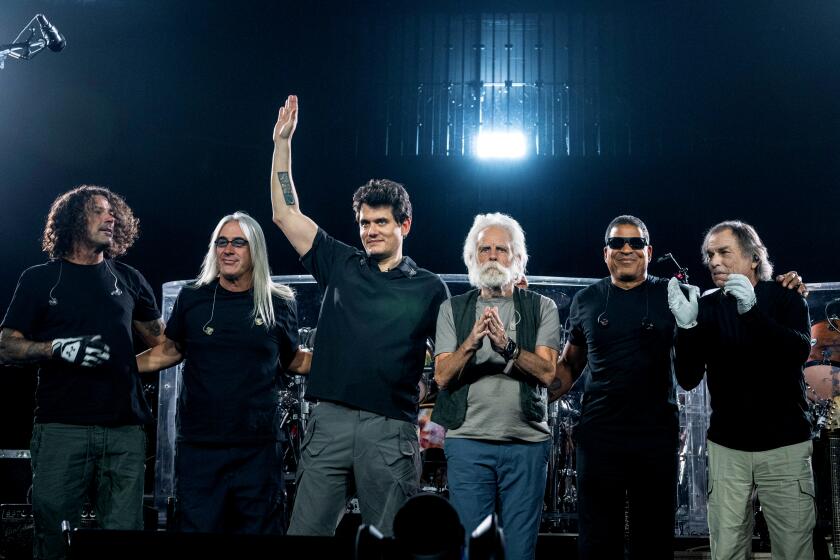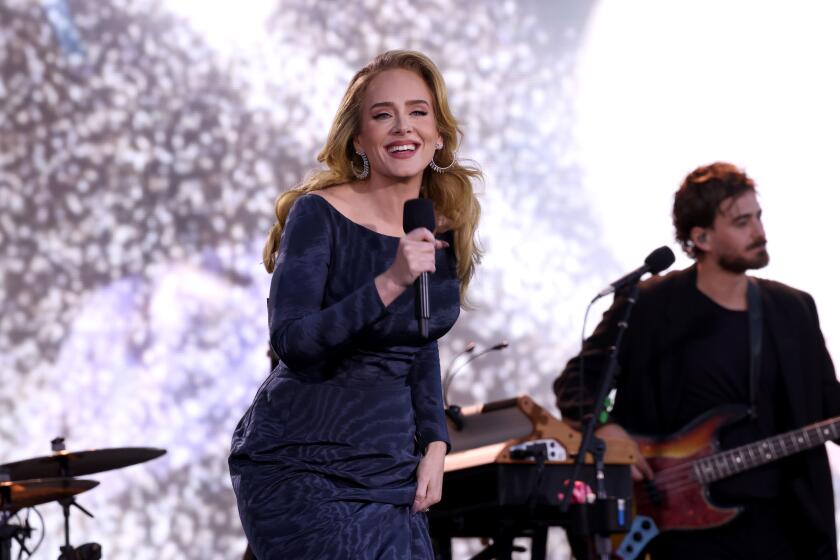Familiar Tunes Never Go Out of Style for Roger Williams
Easy listening never had it so good. Blame it on the fickle tide of culture and fashion, where yesterday’s stale goods become today’s rediscoveries. Blame it on late-blooming recognition of national treasures. But numbers, record company activity, and the sales behavior of the younger music-loving set speak volumes.
Cheesy is in. The 70-something Juan Garcia Esquivel, master of so-called space-age bachelor-pad music, is suddenly a reigning hero, and compilations of music formerly relegated to elevators and the cocktail-lounge scene are filing steadily into stores.
In the heart of the easy-listening section there is pianist Roger Williams, famed melodist and minimalist, who claims to know 10,000 songs. “Don’t quote me on that, but I think that’s about right,” the ever-amiable pianist said in an interview from his home in Los Angeles.
No doubt, he’ll serve up a healthy portion of familiar tunes when he plays the Thousand Oaks Civic Arts Plaza on Friday.
Williams has managed to weather the stigma of being too pleasant and middling for words, but he has done his share to color the American musical landscape.
Listen, again, to the tune that launched a career. Williams’ version of “Autumn Leaves,” recorded in the ‘50s before it became a jazz standard, is a textbook case of pianistic flourish. Williams flutters up and down the keys, playing the melody in octaves and fanciful chordal variations, with leaves-in-the-breeze embellishments aplenty.
Born in Omaha, Williams first sat down to the piano at age 3 and went on to study classical music and jazz--with the notable Teddy Edwards and the under-sung jazz pianist Lennie Tristano. And while Williams gleaned something from those “serious” idioms, he found his popular cruising altitude by paring down to a simple, melody-driven style.
He digs into the tunes, lets the long notes ring, and uses swirls of nuance sparingly. There lies the Williams signature, the sound that made him one of the few instrumental pop artists to strike a lasting commercial chord. He has played for every president from Truman to Bush (Clinton being more inclined toward Kenny G and Fleetwood Mac), and struck up a special rapport with Nixon.
At 71, Williams is enjoying a burst of renewed appreciation, even with audiences a third his age. Thirty years ago, Williams and his easy-listening brethren ran counter to the developing counterculture. Now, his crisply stated piano fancies sound fresher than ever, for camp’s sake and for music’s sake.
*
Will you play with a group in Thousand Oaks?
It will probably be a group of 10 or 11 musicians. The first half is pretty formalized, but the second half is all requests. I take 30 or 40 requests out of the audience and play one [song] in one hand and one in the other. That goes on for 30 or 40 minutes. I don’t play them all the way through, and I don’t play them in the original key, because I’d be modulating all night. Wherever I find myself, I’ll start a song. I have a real good ear. I’m a lousy golfer, but I’ve got a good ear.
*
Obviously you have a well-developed melodic memory. Is that something you were born with?
Yeah. I was really born with a talent. I walked up to the piano at 3 and started to play. I’ve been playing out at the Crystal Cathedral in Garden Grove for about 25 years now. (Rev. Robert H.) Schuller asked me, I said sure. I don’t want to testify; I’d just like to sit down and say thanks to whomever is up there. That’s about the extent of my religion, but I guess it’s a religion. I was given a gift and I’m very appreciative of it.
*
You studied with Lennie Tristano and Teddy Edwards, who are both jazz piano legends. Did that leave an imprint on you?
Oh yeah. I was with Lennie for two years and with Teddy at Juilliard--he was the first black teacher there. The two were so different. With Teddy, anything you wanted to do, he’d say, “Hey, I like that.” He was always kidding. He said, “You’ve got more [talent] in your left hand than I have in my toe.” And I said, “You’ve got more rhythm in your toe than I’ve got in my body.”
But when you got to Lennie, boy, he was a disciplinarian. Every week, I’d have to memorize a Charlie Parker tune and come in and sing it to him. And with my voice, that was pretty hard on Lennie. He was just the opposite from Teddy, because he knew exactly what he wanted you to do and you better damn well do it, or he would really explode.
*
What was the story behind your legendary version of “Autumn Leaves”?
[Producer] Dave Kapp was recording Jane Morgan. She only had three tunes ready for the session. He called me on a Friday night and said, “Do you know a tune called ‘Autumn Leaves?’ ” I said, “You mean ‘Falling Leaves’?” I didn’t even know the title. He said, “If Jane gets through and we have a little time left in the session, why don’t you come in and record it?”
I stayed up Friday and then Saturday night working on an arrangement. Monday morning, I came in and Jane was there, with all these photographers around and the whole bit. I sat over on the corner on the floor. Eleven minutes to the end of the session, Kapp said, “OK, that’s a take with Jane. We don’t even have time to rehearse it. Let’s just play it.”
I played it and it timed out at three minutes and five seconds. In those days, a jockey wouldn’t even play a song that was over three minutes. So Kapp said, “Can you play those thirds a little bit faster?” So we had one more take, and it turned out to 2:59.
I owed two months’ rent on our apartment. I had a wife and a baby at the time. My fondest dream for “Autumn Leaves” was that it would pay the rent. And, boy, it’s been doing it ever since.
*
That really kicked off your career, didn’t it?
Yeah, that and “Born Free” and “Impossible Dream.” We had some big hits.
*
Do you spend a lot of time thinking about what you can do to adapt these tunes to piano in a new way?
When I first started recording for Dave Kapp, I was really in a jazz thing. He finally said to me, “You know, you play a lot like Andre Previn. But I’ve never heard anybody play the words like you do.” I always memorize the lyrics to every tune, so I can phrase like a singer.
*
Veteran pop artists like Tony Bennett and Mel Torme have been recently rediscovered by young audiences. Have you noticed a new burst of interest from the younger set?
I’ve noticed it in our audiences. We’ve always had good audiences. I’ve never stopped, but the audiences are getting younger. This last week, they invited me to lecture at a music class at Cal Lutheran. Every year, I go down to Epcot and conduct the All-American Youth Orchestra. Some of these kids are just phenomenal, marvelous musicians. Man, they’re into everything, as I am.
I just picked up the Eliane Elias album with Herbie Hancock--it’s a great album. And I love Chick Corea. He and (his wife) Gayle are dear friends. I record over there at Mad Hatter. I listen to everything. I steal from everybody.
*
Are you recording these days?
I just did an album with the Royal Philharmonic in England, for Reader’s Digest. And I’m supposed to do one for MCA, and one for Heartland Music. So it just keeps going.
I remember when I made my first album, I came home and told my wife, “Boy, I hope they don’t ask me to make another album, because I used all my ideas on this one.” One-hundred and nine albums later, I’m still grinding ‘em out.
DETAILS
* WHO: Roger Williams.
* WHEN: 8 p.m. Friday.
* WHERE: Thousand Oaks Civic Arts Plaza, 2100 Thousand Oaks Blvd.
* HOW MUCH: $22-$35.
* CALL: For tickets or information, call 449-ARTS (449-2787).
More to Read
The biggest entertainment stories
Get our big stories about Hollywood, film, television, music, arts, culture and more right in your inbox as soon as they publish.
You may occasionally receive promotional content from the Los Angeles Times.









